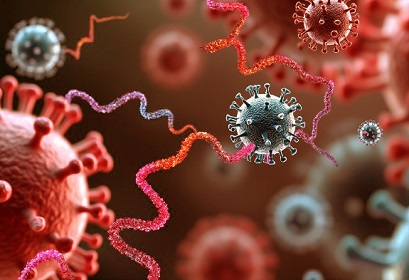New Discovery Reveals How ISG15 Protein Fights COVID-19 and How the SARS-CoV-2 Virus Strikes Back
Nikhil Prasad Fact checked by:Thailand Medical News Team Oct 24, 2024 1 year, 1 month, 2 weeks, 2 days, 2 hours, 37 minutes ago
Medical News: South Korean researchers from Sungkyunkwan University, Korea University, and Yonsei University have uncovered a fascinating new way that the body fights off SARS-CoV-2, the virus responsible for COVID-19. Their study sheds light on how a protein called ISG15 plays a critical role in suppressing the virus, and how SARS-CoV-2, in turn, counters this immune defense.
 New Discovery Reveals How ISG15 Protein Fights COVID-19 and How the
New Discovery Reveals How ISG15 Protein Fights COVID-19 and How the
SARS-CoV-2 Virus Strikes Back
The Role of ISG15 in Viral Defense
The immune system is equipped with a wide variety of tools to combat infections, and one such tool is the protein ISG15. ISG15 is part of a defense mechanism known as ISGylation, where ISG15 attaches itself to proteins, modifying their function. In the context of viral infections, ISGylation helps slow down or even stop the virus from spreading by interfering with its proteins.
When SARS-CoV-2 invades the body, ISG15 steps in by attaching itself to viral proteins, particularly the nucleocapsid (N) protein, which is vital for the virus’s replication and spread. This
Medical News report will explain how researchers discovered this process and the fascinating ways that ISG15 inhibits the virus from multiplying.
The Importance of Nucleocapsid (N) Protein
The N protein is a key player in the life cycle of SARS-CoV-2. It helps the virus package its genetic material and ensures that new viral particles are efficiently produced. The N protein forms dimers - pairs of molecules that work together - crucial for this process.
However, the research team found that ISG15 disrupts the dimerization (pairing) of the N protein. By binding to a specific site on the N protein called Lysine 261 (K261), ISG15 prevents the protein from forming these dimers, effectively stopping the virus in its tracks.
How ISG15 Inhibits the Virus
The study involved several experiments where the researchers introduced ISG15 into cells infected with SARS-CoV-2. They found that ISG15 attached itself to the N protein at multiple sites and also at the most important site which is K261. By binding to K261, ISG15 prevents the N protein from carrying out its essential functions.
To test this, the researchers created a mutant version of the virus where K261 was altered, preventing ISG15 from attaching to this site. The mutant virus showed greater resistance to the body’s immune responses, particularly the interferon responses that typically help fight off infections. This demonstrated just how important ISGylation at K261 is for controlling the virus.
How the Virus Fights Back: The Role of PLpro
SARS-CoV-2 has developed its own counter-defense to neutralize ISG15. The virus produces an enzyme called PLpro, which can remove ISG15 from the N protein, allowing the virus to bypass this immune defense. PLpro is part of a larger viral protein called NSP3, which plays a critical role in helping the vir
us survive inside human cells.
The researchers found that PLpro effectively removes ISG15 from the N protein, restoring the protein’s ability to form dimers and enabling the virus to continue replicating. This tug-of-war between ISG15 and PLpro highlights the complex battle that takes place inside infected cells.
Implications of the Study
This discovery could have significant implications for the development of new treatments for COVID-19. By understanding how ISG15 and PLpro interact, scientists may be able to develop drugs that enhance ISG15’s ability to suppress the virus or inhibit PLpro’s ability to remove ISG15.
Moreover, the study sheds light on how SARS-CoV-2 might evolve to resist the body’s defenses. The researchers analyzed millions of virus samples and found that some variants of SARS-CoV-2 had mutations in the sites where ISG15 attaches, such as K261. This suggests that the virus may evolve over time to evade ISGylation and become more resistant to immune responses.
Study Methods
The study involved various techniques to explore the interaction between ISG15 and the N protein. Researchers used co-transfection assays to introduce ISG15 and other viral proteins into cells. By observing how ISG15 modified the N protein, they could pinpoint the exact sites where ISG15 binds and how this affects the virus.
They also created a mutant version of the virus that was resistant to ISGylation at K261. This mutant virus allowed them to compare its growth and response to immune signals like interferon with the original virus. The findings showed that the mutant virus was more resistant to interferon, confirming the importance of ISGylation in controlling the infection.
Potential for Therapeutic Development
The findings open up new possibilities for therapeutic interventions. Drugs that mimic the effects of ISG15 or enhance its ability to attach to viral proteins could offer a new way to combat COVID-19. On the other hand, inhibitors that target PLpro could prevent the virus from escaping this immune mechanism.
Conclusion: The Ongoing Battle Between Virus and Immune System
This study provides valuable insights into the complex interactions between SARS-CoV-2 and the immune system. ISG15 is a powerful tool that the body uses to fight off the virus, but SARS-CoV-2 has evolved countermeasures like PLpro to neutralize this defense. Understanding this dynamic could lead to new strategies for treating COVID-19, particularly in cases where the virus has become resistant to existing treatments.
The study findings were published in the peer-reviewed journal: Frontiers in Microbiology.
https://www.frontiersin.org/journals/microbiology/articles/10.3389/fmicb.2024.1490944/full
For the latest COVID-19 News, keep on logging into Thailand
Medical News.
Read Also:
https://www.thailandmedical.news/news/study-identifies-seven-hub-genes-ifi44,-ifi44l,-mx1,-oas3,-usp18,-ifi27-and-isg15-as-potential-therapeutic-targets-for-sars-cov-2-omicron-infections
https://www.thailandmedical.news/news/study-finds-that-inflammation-causes-heart-cells-to-produce-a-protein-called-isg15-that-sticks-to-other-proteins-causing-heart-failure
https://www.thailandmedical.news/news/latest-research-shows-that-sars-cov-2-suppresses-ace2-activity-in-covid-19-patients-while-inducing-expression-of-the-interferon-stimulated-genes-isgs
